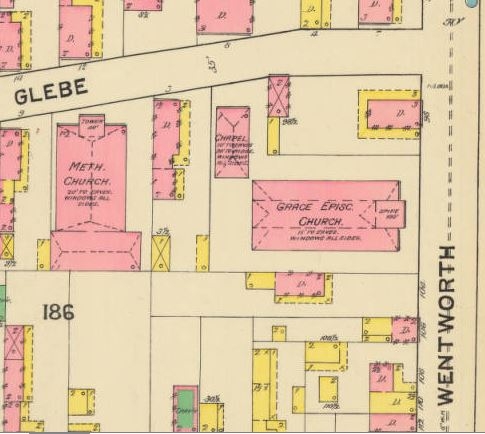98 Wentworth Street
City Directories and History: GRACE EPISCOPAL CHURCH
Constructed 1847-48; various twentieth – century additions; restored 1991 – Edward Bricked White, architect; E. W. Brown, contractor
“Charleston’s restoration architect Albert Simons once remarked that the silhouette of the steeple of Grace Episcopal Church, with its successive pinnacles, recalled the steeple of St. Mary the Virgin on High Street in Oxford. Edward B. White’s approach to the Gothic Revival style apparently emanated from Oxford, and after completion of his initial
essay in this form, the Huguenot Church, he embarked on two other commissions in the late-1840s: Grace Church for a new Episcopal congregation on the old glebe lands adjacent to Harleston Village, and a larger structure for the congregation of Trinity Church (now Trinity Cathedral) in Columbia. His contractor, E. W. Brown, supervised construction of both buildings. When completed, the multi tiered steeple with corner pinnacles surmounted by tall spire had, as intended, a significant effect upon the suburban landscape.
The arched Gothic window over the principal doorway and similar windows down both sides of the structure, as well as Gothic friezes in stucco and other details, hinted at the elaboration of the interior, with its vaulted nave, side aisles, and apsidal chancel. Although its chancel tablets and interior plaster arc original, the altar window, rear window, twelve clerestory windows, and several other windows were planned by Ralph Sadler Meadowcroft, an Anglican rector who served the congregation for several decades. In the restoration after Hurricane Hugo, the original paint scheme, intended to create the impression of stone blocks, was restored, as was the gilded decoration in the chancel. Grace Church closed on January 20, 1864, because of shelling of the city by Union forces on Morris Island. Although damaged by a shell, it was the first Episcopal church to reopen in the city after the war.
Local tradition holds that when a Union commander ordered the rector, the Reverend Charles Cotesworth Pinckney, to pray for the president of the United States, with Union soldiers standing at attention in the aisle, Pinckney replied, “I will gladly obey your order, sir. I know of no one who needs praying for more than the president of the United States.”
Information from: The Buildings of Charleston – J.H. Poston – Author, for the Historic Charleston Foundation, 1997
Other sources of interest: Charleston Tax Payers of Charleston, SC in 1860-61 and the Dwelling Houses of Charleston by Alice R.H. Smith – 1917 The HCF may also have additional data at: Past Perfect and further research can be uncovered at: Charleston 1861 Census Schedule
Stay Connected
Explore history, houses, and stories across S.C. Your membership provides you with updates on regional topics, information on historic research, preservation, and monthly feature articles. But remember R&R wants to hear from you and assist in preserving your own family genealogy and memorabilia.
Visit the Southern Queries – Forum to receive assistance in answering questions, discuss genealogy, and enjoy exploring preservation topics with other members. Also listed are several history and genealogical researchers for hire.
User comments welcome — post at the bottom of this page.
Please enjoy this structure and all those listed in Roots and Recall. But remember each is private property. So view them from a distance or from a public area such as the sidewalk or public road.
Do you have information to share and preserve? Family, school, church, or other older photos and stories are welcome. Send them digitally through the “Share Your Story” link, so they too might be posted on Roots and Recall.
Thanks!
IMAGE GALLERY
User comments always welcome - please post at the bottom of this page.














Share Your Comments & Feedback: